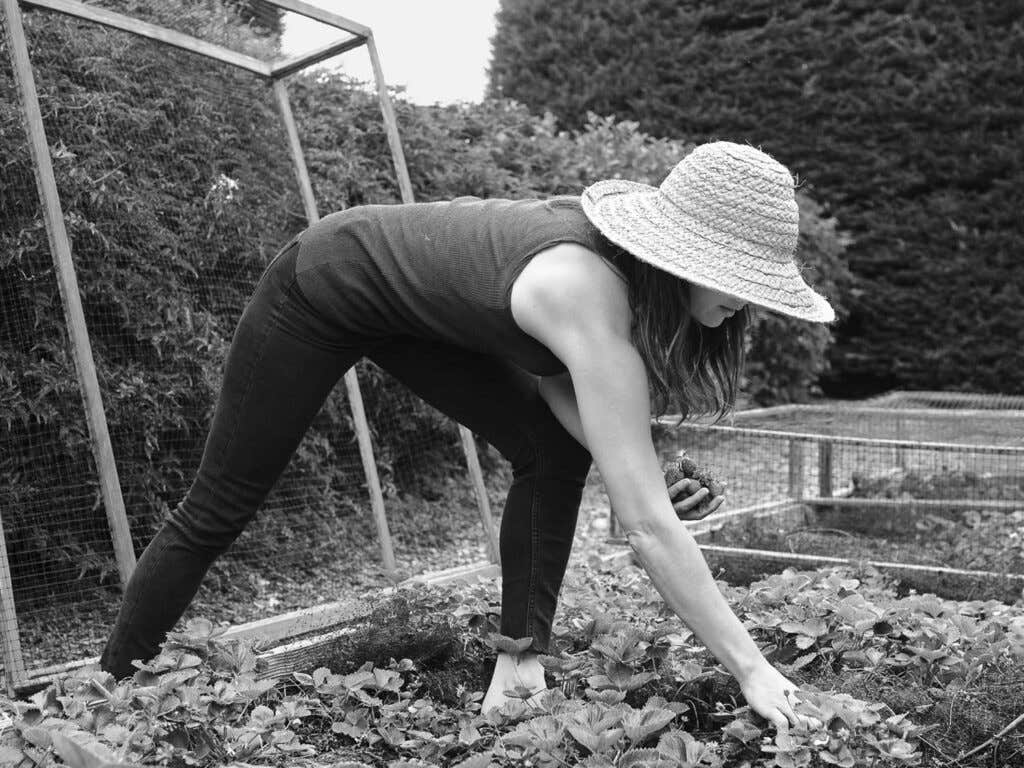
‘A Simple Green Salad’: Fanny Singer’s Litmus Test for a Good Restaurant
Alice Waters’ daughter explains her family’s favorite dish.
In the writer Fanny Singer’s childhood home in Berkeley, California, her mother, the chef Alice Waters, makes her own red wine vinegar. It’s in a little cask with an old mother that’s been active for decades. Waters decants all the red wine that doesn’t get finished and puts it in there, tasting as she goes and correcting as needed. “She’s like a little chemist, mixing the different vinegars,” Singer chuckles over the phone. This homemade red wine vinegar is one of the key ingredients in the salads Singer and Waters make for themselves every day.
Since quarantine, the two have been living together and eating way more lettuce than usual. “We’ve always had a garden with great vegetables and herbs, but have never, until now, had a dependence on greens,” Singer tells me. “But when the pandemic happened, we were going through lettuce so quickly. We needed to grow more.”

Singer recalls a time, decades ago, when their whole back garden was filled with rows and rows of lettuce. Her mother got seeds from her godmother and planted mesclun greens. “My mom grew the salad for Chez Panisse back then,” Singer says. Now, the lettuce comes from Bob Cannard, whom she calls “arguably the best farmer in North America.”
As Singer and I wax lyrical about lettuce for what feels like hours, she tells me about one particular trip she took with her mother to Japan. At a restaurant there, she had, for the first time in her life, various wild harvested greens, buds, ferns, and shoots that were only available for a short two weeks, right at the beginning of spring. The chef turned them into tempura, which laced the deep, nuanced bitter greens in a crisp batter that was at once sweet, savory, and salty. “There was a real sense of temporality,” she tells me. “You eat these things right in their moment to remind you of the winter that has just passed, and that you have to continue to eat to move on.”
For Singer—whose chewy, lyrical food memoir, Always Home, came out earlier this year—the key to a restaurant’s success is this care for ingredients, and an understanding that the best food starts with a strong relationship with farmers. “If you have good greens,” she says, “you don’t need much else.” Her mother shares this ethos, both at her restaurant, which is famously known for its locally grown California produce, but also when traveling with her daughter. As Singer reveals in my favorite chapter dedicated to salad:
The mother and daughter’s lifelong adoration for “a few leaves” has meant that a simple green salad—to be specific, “a plate of crisp, beautiful leaves, dressed in the correct amount of balsamic-free dressing,” as Singer writes in the memoir—has become the family’s litmus test for a good restaurant. It also happens to be “a very straightforward way for Chez to telegraph its central values. Even the humblest dish on the menu is special.”
And it is. As I recall my first meal at Chez Panisse years ago, it’s that first bite of salad—a fresh, crunchy Little Gem number—that would stick with me for life. “Oh, this is what they mean by farm-to-table,” I said to my date at the time. The lettuce itself wasn’t just perfectly textured, cool and crisp; it was sweet and flavorful, as well. I had never tasted lettuce like that—never even knew lettuce could taste like that.
What drew me most to writing an entire piece about this salad is the ritual that goes into making it, not just at Chez Panisse, but at the Waters household, too. From the avicerating of the garlic clove in a Japanese mortar to the drying of the lettuce, salad prep for Singer and Waters sounds almost religious. “My mom is very noise averse. She hates vacuum cleaners, salad spinners,” Singer says. Which is why Waters keeps on hand six to eight cloth towels specifically designated for drying lettuce—and she won’t let her daughter use them for anything else. There’s a real ritual to this lettuce drying practice, not in any precious, sentimental way, Singer emphasizes. “Just in a caring way.”
Recipe: Simple Chez Salad Dressing
This is basically the dressing I make at home, though I’m flexible about which types of acid I incorporate, often replacing the Banyuls vinegar that Chez uses with a bit of sherry or apple cider vinegar or lemon juice. Start by placing a clove of garlic and ½ teaspoon of sea salt in a Japanese-style mortar (suribachi) or marble mortar and use your pestle to grind it to a translucent paste. Cover the garlic with 1 tablespoon of red wine vinegar and 1½ tablespoons of Banyuls vinegar and allow it to sit for at least ten minutes so that the acid has time to mellow the heat of the allium. Whisk in a scant ½ teaspoon of Dijon mustard and then add 6 tablespoons of extra virgin olive oil, beating vigorously to emulsify. Add a grind of black pepper at the end and taste, adjusting for acid balance and salt—I like mine on the acidic side, so tend to err on the more vinegar end of the spectrum. Use this to dress enough salad for six.
—Fanny Singer
Excerpted from Always Home: A Daughter’s Recipes & Stories by permission of Alfred A. Knopf, a division of Penguin Random House LLC. Copyright © 2020 by Fanny Singer. All rights reserved.
Keep Reading
Continue to Next Story










